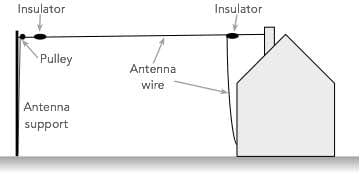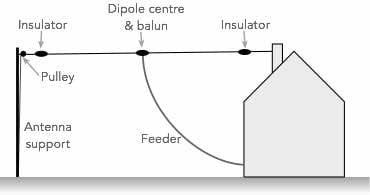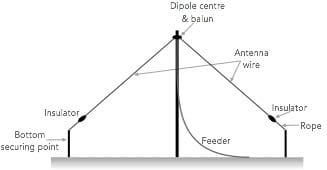Choosing & Buying Best Ham Radio Antenna
How to select the best antenna for a ham radio station to provide the optimum performance and greatest flexibility.
Setting up an Amateur Radio Station Includes:
How to set up amateur radio shack
Buying best HF gear
Buying best VHF/UHF equipment
Linear amplifier
How to buy kits
Buying used equipment - a guide
Choosing & buying the best antenna
Possibly one of the most difficult choices for any amateur radio station is the choice of the antenna.There is always a good discussion to be had on what types of antenna perform the best under given circumstances. For some the choice may be a large directive antenna on a high tower, but for most radio amateurs space and many other restrictions mean that compromises have to be made.
When there are restrictions the challenge is to adopt the best form of antenna for the particular location. This can often lead to some experimentation which is normally very interesting and leads to a much better understanding of the operation of antenna systems and two way radio communication in general.
There are many options for amateur radio antennas that can be taken, some simple, some that can be made, some that are bought . . but whatever type of antenna is chosen, it will be interesting to see the results. Some of the very many options for antennas are given below.
End fed wire antenna
The end fed wire, often called a long wire antenna is one of the simplest to build and install. Simply it consists of a length of wire that is connected to the receiver or transmitter.

Often this type of antenna is called a long wire antenna, although a true long wire antenna is many wavelengths long, rather than a random length, often only less than a wavelength. The more correct terminology is an end fed wire.
Erecting this type of ham radio antenna is quite straightforward. A typical antenna installation is shown in the diagram, but it can be almost any suitable configuration.
An antenna tuning unit will be required - one which can interface to an end fed wire. This is placed between the transmitter or receiver and the antenna wire. If one is not used, then the impedance of the antenna will not match that of the receiver or transmitter input and this will result in lower efficiency. Also the transmitter may have trouble matching to this, and this may result in lower power output, or even damage to the transmitter output.
It is also necessary to have a good earth connection. This should not just be the mains earth that the rig or power supply uses - this would not provide a good RF earth connection and it can result in interference to other electrical and electronic items.
It is often thought that an end fed wire should be a quarter wavelength long on the major band of use. This presents a low impedance to the radio and enables it to be matched very easily. However the current maximum which gives rise to the radiation occurs around this area and this means that there is lots of pick-up and radiation near the radio. This is not good as it results in local pick-up of noise etc and this can mask the wanted signals. Also for transmitters, lots of radiation occurs near the radio and this can cause interference to many other problems with electrical and electronic items. Even if the antenna is not a quarter wavelength long, some pick up and radiation will occur near the radio and this is not good.
If the antenna is not an odd multiple of quarter wavelengths long, then it can be difficult to match.
- Low cost
- Multiband operation possible
- Simple to erect and install
- Can receive high levels of local interference
- Can give rise to interference to other local users
- Requires good earth connection
Although the end fed wire can seem like a good option for amateur radio communication applications, it does have some drawbacks and may not provide the optimum overall performance.
End fed half wave, EFHW antenna
One popular antenna that is being used increasingly is known as the end fed half wave antenna, or EFHW antenna.
This type of wire antenna is a half wavelength long at its lowest frequency. Being a ham radio antenna, the many of the higher frequency bands are harmonically related, and therefore it will perform as a multiple number of half wavelengths on these bands.
The antenna is fed with 50Ω coaxial cable, and to provide an acceptable match to this, an RF transformer with a step up impedance is used. Values of 9:1 are widely used for these end fed half wave antennas, but some designs may even use ratios of up to 50:1 - this equates to a turns ratio of around 1:7 or 1:8.
The RF transformer used is referred to as an unun as it matches from an unbalanced line to an unbalanced antenna - the more familiar balun goes from balanced to unbalanced.
Being a high impedance antenna an earth connection is not needed. Typically a counterpoise is used. If a counterpoise is not present then the antenna will use the coax outer. In this case it is worth placing an RF choke over the coax to prevent RF from entering the shack, etc.
Using this set up it is possible to place the unun and hence the radiating antenna section away from the house, using the run of coaxial feeder. This will reduce radiation into the house and wiring and also it will reduce pickup from local electrical and electronic equipment.
An antenna tuning unit is required by the radio transmitter to ensure that the level of VSWR it sees can be reduced to a low level. There is likely to be a higher level of VSWR in the coax between the ATU and the Unun. This will introduce some loss, but it will not be noticeable if good quality coax is used and frequencies are below 30MHz or so, which they normally are for this type of antenna.
- Relatively low cost
- Multiband operation possible
- Simple to erect and install
- Fewer local interference issues
- Requires use of counterpoise
- Can still have higher level of interference than balanced antennas
- Requires ATU to be used
- Higher cost than basic end fed wire due to Unun
Wire dipole
One of the simplest and most cost effective antennas for radio communication is the dipole. If mounted as high as possible it can perform very well. As the length of the dipole determines its frequency of operation, these antennas are normally only used for a single band, although there are versions that can be used for HF multi-band operation.
On occasions a dipole may be used at VHF, especially for 6 metres, although often they are the driven element for a directive antenna such as a Yagi.
Wire dipole antennas on their own are widely used for HF amateur radio communication.

Dipoles are straightforward in their design and hence they are quite easy to make. Often wire cut to length for the frequency of operation and fed at the centre.
- Relatively low cost
- Simple to erect and install
- Components for dipole cheap and easy to obtain
- Often only single band operation
- Wire dipoles often need two high anchor points
Note on HF amateur band antenna:
The dipole works well as an HF antenna for amateur radio communications. It is simple and easy to construct and erect.
Read more about an HF ham radio dipole antenna.
Inverted V dipole
One of the disadvantages of the normal horizontal dipole for HF is that two high anchor points are required and this may not always be easy to find.
One way of overcoming this is to use what is termed an inverted V dipole. As the name suggests it has a central single high point and the two sections of the dipole coming down towards the ground.
Care needs to be exercised when mounting the two ends of the wires because they can have high voltages when sued for transmitting. These ends should not only be insulated for performance reasons but they must be kept out of reach, especially of young children.
The inverted V dipole provides an almost omnidirectional polar pattern in the horizontal plane. This can be an advantage in some situations.

- Relatively low cost
- Simple to erect and install
- Components for dipole cheap and easy to obtain
- Only requires one high mounting point
- Care needs to be exercised when fixing the two low ends as they can have high voltages when used for transmitting
- Wire lengths are slightly different to those of the horizontal dipole.
Note on HF inverted V antenna:
The inverted V dipole antenna has the advantage that it requires only one central high point on which to be mounted. This enables these antennas to be erected more easily than horizontal dipoles in many situations.
Read more about an HF inverted V dipole antenna.
HF wire doublet
The doublet is actually a form of dipole, but using an open wire feeder and an antenna matching / tuning unit, it can be used on a variety of bands. The drawback for the doublet is the open wire feeder which cannot easily be run though a house without becoming unbalanced.
The doublet antenna is normally used for the HF bands, where typically the lowest frequency of operation is where the antenna forms a half wavelength.
One development of the doublet antenna for ham radio communication applications os the G5RV antenna. This provides a sufficiently good match on most of the HF ham radio bands and being a simple wire antenna, this makes it very attractive for many ham radio stations.

- Relatively low cost
- Multiband operation possible
- Simple to erect and install
- Manufactured versions are readily available
- Requires the use of an ATU
- Does not provide a good match on all HF bands
Note on G5RV antenna:
The G5RV antenna is a popular form of antenna for HF amateur radio communication where it provides multiband operation and without being excessively large. It can fit within many domestic gardens, although it may need to be bent to fit some plots.
Read more about the G5RV antenna.
Vertical antenna
The vertical antenna is ideal in many situations. Being vertical, the maximum radiation is parallel to the earth’s surface in an ideal world, and in reality it has a lower angle of radiation than a horizontal dipole under most circumstances. It also has omnidirectional radiation pattern in the horizontal plane enabling all-round radiation and it does not need to be orientated to receive signals from different directions. This can be an advantage at HF and also VHF / UHF.
For HF it occupies much less space than, for example a dipole, and therefore it can fit into many small garden plots. It can be run against a proper ground, or elevated using a radials acting as a ground plane. This gets the vertical higher and enables it to have a much clearer take-off.
There are many HF verticals available for sale, often they are a quarter wavelength long, and many have traps (tuned circuits) that isolate sections of the antenna to provide multiple band operation. These antennas are made commercially and can provide an ideal solution for many. They can be ground mounted and this enables them to take up little space, although being ground mounted they are not high and can be shielded by buildings and other objects. When operated like this they need a very good ground connection - in areas on sandstone, the earth connection will be poor and these antennas will not work as well this way.
It is also possible to raise these antennas and use a ground plane. Although it increases the space required, these systems can perform well, especially if they are mounted on the top of residential buildings, etc.
Some HF verticals may operate as a half wavelength. Although taller, and requiring a matching system within the antenna, this approach does reduce the need for a very effective earth or ground plane system.
For VHF / UHF vertical antennas are widely used for FM operation. As many stations using FM are mobile, the omnidirectional radiation pattern means that antennas do not need to be re-orientated as the vehicle moves. Accordingly vertically polarised antennas are standard for FM at VHF and UHF.
Often extended length verticals such as 5/8 wavelength verticals may be used to reduce the angle of radiation, i.e. kept the radiation closer to the ground for more effective radio communication.
Various designs for VHF verticals are available - many are two, three and even four bands, and some use techniques to reduce the need for a ground plane. The basic quarter wave vertical, however still needs a ground plane.
- Provides low angle of radiation for longer distances and better coverage
- Can occupy a small area
- Require more mechanical strength than horizontal wire antennas
- Requires good earth connection or ground plane
Note on vertical antennas:
Vertical antennas are used in many instances from MF broadcasting to VHF / UHF mobile communications. Being vertical in construction, they provide all round coverage for transmission and reception combined with a low angle of radiation.
Read more about vertical antennas.
Directional antennas - Yagi
Many stations require additional gain over dipoles and vertical antennas and antennas like the Yagi are common, both at HF and they are almost exclusively used for longer distance operation at VHF and UHF.
For HF operation a tower is often required, and accordingly a reasonable sized plot of land is needed. Planning permission is also needed in many countries.
For VHF and UHF the antennas are more manageable and can often be mounted on fixings attached to the house, although large tower may still be used where space permits.
- Directivity provides gain in the required direction
- Directivity can reduce interference from signals from different directions
- Most Yagi / directional antennas are mounted higher up and this provides gain
- Much more costly
- Additional height requires longer coaxial feeder lengths which can add to losses - good coax is needed
- Visual impact can be an issue, especially for neighbours
- Increased risk of lightning damage / strike
Note on Yagi antennas:
Yagi antennas are one of the most popular forms of directional antenna. Widely used as television antennas, they are also used for very many other applications from HF to VHF, UHF and beyond, providing directivity and gain.
Read more about Yagi antennas.
The summary given above provides insights into the main types of antenna used. There are many different types of antenna that can be used for amateur radio.
Check out the Electronics Notes: Essential Ham Radio List.
Choosing the best antenna for any radio amateur station can be very interesting and provide many hours of experimentation. Experimenting with antennas can give some useful insights into the operation of different types, although the differences between them may be marginal in some instances. In general greater height and keeping them away from sources of interference and objects that will mask and detune them is best.
 Written by Ian Poole .
Written by Ian Poole .
Experienced electronics engineer and author.
More Ham Radio Topics:
What is ham radio
Callsigns
Morse code
Voice modes
Digital data modes
QRP operating
Operating awards
Codes & abbreviations
Ham bands overview
Operating via differnet propagation modes
Repeaters
Callsigns
Contact formats
Setting up a shack & buying equipment
Return to Ham radio menu . . .



